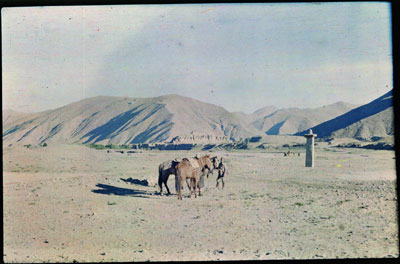
BMR.6.8.80 (Transparency colour)


BMR.6.8.80 (Transparency colour)

Hugh E. Richardson
Hugh Richardson
1936-50
Chyongye Valley Region > Chyongye
BMR.6.8.80
60 x 90 mm
Richardson's 1949 tour of the Yarlung and Chyongye valleys
Technical Information - The camera used to take this collection of colour slides (Dufay colour) were a Zeiss Super Ikonta and a Reflex Korelle. [KC 09/10/2006]
Manual Catalogues - Typewritten handlist entitled 'Hugh Richardson Collection, The British Museum. Photographs taken between 1936-50. Cameras: Zeiss Super Ikonta, Reflex Korelle. 300 colour slides (Dufay colour); copies made Jan. 1995.
[no.] 80. The commemorative pillar of Trisong Detsen. It stands near the burial grounds of Chonggye. (See HR's Corpus of Early Tibetan Inscriptions .' [KC 10/10/2006]
Other Information - History: Richardson discusses this pillar in A Corpus of Early Tibetan Inscriptions, H.E. Richardson, James G. Forlong Series, no. xxix, London Royal Asiatic Society, 1985, pp. 36-41 'The rdo-rings near the bridge-head at 'Phyong-rgyas". "This pillar stands in an exposed position to the south of a small bridge over the stream below the rdzong at 'Phyong-rgyas beside the track leading to the tombs of the kings ( bang-so ) about half a mile distant. The north face once bore an inscription; on the southface are carved the figures of a lion and a dragon now rather indistinct. When I visited the place in 1949 the north face ahd been so severely eroded by wind and sand that only a few letters could be read. ... The inscription probably falls within the five years between 795 and 800." (p.36) [KC 27/9/2006]
Other Information - Location: Richardson wrote an article about the location and the historical significance of the early burial grounds in the Chyonggye valley near Yarlung in Central Asiatic Journal , 8,2 (1963), pp. 73-92 reproduced in High Peaks, Pure Earth , London, Serindia Publications, 1998, pp. 219-233. "'Phyong-rgyas is some sixty-five miles south-east of Lhasa, near the head of a tributary of the Yar-lung Chu which flows south into the Gtsang-po near Rtse-thang. There, in brooding and majestic solitude, rise the burial mounds of the kings ... . Not far away to the north, at the foot of the hills which enclose the valley, is the village of 'Phyong-rgyas dominated by its rdzong ; and on a sheltered hillside above the village there is the Dge-lugs-pa monastery of Ri-bo bde-chen. Higher up the steep ridge on which the rdzong stands are the ruins of what is traditionally identified with Phying-ba'i Stag-rtse, the ancient stronghold of the Tibetan kings." (219-220) "There is ... near the village of 'Phyong-rgyas, and at some distance from the tombs, a fine stone pillar bearing faint traces of lettering of which the only legible part - when I saw it - was the name Khri Srong-lde-brtsan. ... What the pillar is doing in its present position is not clear. The place where it stands is level ground with no suggestion that there was ever a mound anywhere near it nor does it appear probable that an important tomb would be built at such a distance from the main burial ground. ... The inscription ... is a brief eulogy of the king in general terms. ... " (225) "The pillar ... bears on its south face the outline of a lion, incised in low relief. The carving is so faint it cannot be detected in the photograph. Its head is towards the left hand corner of the pillar and its two forefeet can be seen a little lower down. Below it are traces of a dragon in the Chinese manner. The free drawing of the lion and the stylized representation of the dragon are an interesting contrast." (229) [KC 30/5/2006]
For Citation use:
The Tibet Album.
"Tride Srongtsen's inscription pillar in the Chyongye valley "
05 Dec. 2006. The British Museum.
<http://tibet.prm.ox.ac.uk/photo_BMR.6.8.80.html>.
For more information about photographic usage or to order prints, please visit the The British Museum.
© The British Museum